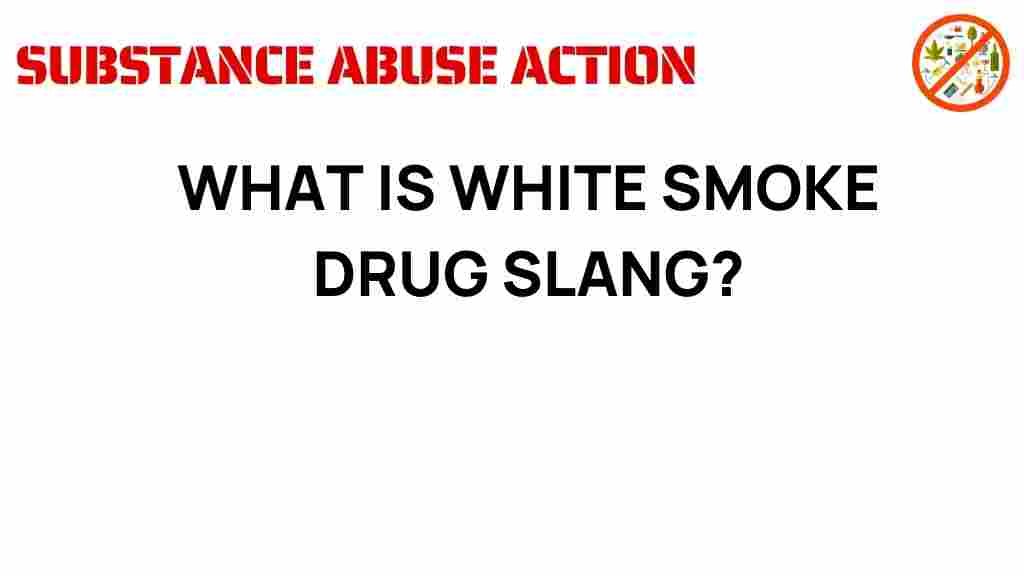Unraveling the Mystery of White Smoke
In the realm of substance use and youth culture, terminology can often be misleading or confusing. One term that has garnered attention in recent years is white smoke. While it may evoke images of vapor or smoke, its implications within the context of drug slang are far more serious. This article aims to illuminate the meaning of white smoke, delve into its connections with illicit drugs, and provide insights into awareness and prevention regarding substance abuse and addiction.
What is White Smoke?
The term white smoke refers to the vapor or smoke produced by certain substances when they are heated or burned. In the context of drug use, it is often associated with the inhalation of drugs that produce a white, smoke-like residue. This can include various illicit drugs, such as:
- Marijuana
- Cocaine
- Heroin
- MDMA (Ecstasy)
Understanding the terminology is crucial for parents, educators, and young people themselves, as it helps in recognizing the potential dangers that accompany substance abuse.
The Connection Between White Smoke and Substance Abuse
White smoke is not just a visual phenomenon; it represents a broader issue within youth culture. The allure of smoking drugs lies in the immediate effects and the social acceptance that may accompany it. However, this behavior can quickly spiral into addiction. Here are some common connections between white smoke and substance abuse:
- Instant Gratification: Many drugs that produce white smoke are sought after for their immediate effects. This instant reward can lead to repeated use and dependency.
- Social Pressure: Young individuals may feel compelled to experiment with drugs due to peer pressure, often glamorized through media and youth culture.
- Lack of Awareness: Many young people may not fully understand the risks associated with smoking drugs or the terminology used to describe them.
Understanding the Impact of White Smoke in Youth Culture
To effectively address the issue of white smoke and its ties to substance abuse, it’s essential to explore its impact on youth culture. The normalization of drug use in various social circles can lead to dangerous misconceptions about the safety and legality of these substances.
Common Misconceptions
Many young people may hold misconceptions about white smoke and smoking drugs, including:
- “It’s just a phase.” Many believe that drug use is a temporary stage in adolescence, disregarding the potential for long-term addiction.
- “It’s safe if shared among friends.” The idea that using substances in a social setting diminishes the risks is a dangerous myth.
- “I can stop whenever I want.” This belief can prevent individuals from recognizing their addiction.
Recognizing the Signs of Substance Abuse
Understanding the signs of substance abuse, particularly relating to white smoke, is crucial for early intervention. Here are some signs to look for:
- Changes in behavior or mood
- Neglecting responsibilities
- Physical health issues, such as respiratory problems
- Isolation from family and friends
The Role of Education in Prevention
Education plays a pivotal role in prevention efforts. Schools and community organizations must prioritize substance abuse education to raise awareness among youth. Here are some strategies:
- Workshops and Seminars: Hosting educational events can provide essential information about the risks associated with drug use.
- Peer Education Programs: Engaging students in peer-led discussions can facilitate open dialogues about substance abuse and its consequences.
- Parental Involvement: Encouraging parents to participate in educational sessions can help them understand the challenges their children face.
How to Talk to Youth About White Smoke and Substance Abuse
Having open and honest conversations about white smoke and substance abuse can empower youth to make informed decisions. Here are some tips for parents and educators:
- Encourage Open Dialogue: Create a safe space for youth to share their thoughts and feelings without fear of judgment.
- Provide Accurate Information: Ensure that discussions are based on factual information regarding the effects of drugs.
- Listen Actively: It’s essential to listen to the concerns and experiences of youth to build trust and understanding.
Utilizing Resources for Support
There are various resources available to support both youth and their families in addressing substance abuse:
- National Institute on Drug Abuse – Offers comprehensive information about drugs and their effects.
- SAMHSA’s National Helpline – A confidential resource for individuals facing substance abuse issues.
- Local counseling services that specialize in addiction treatment.
Troubleshooting Tips for Recognizing and Addressing Substance Abuse
If you suspect someone is struggling with addiction, especially related to white smoke, consider the following troubleshooting tips:
- Observe Behavior: Look for changes in behavior, social circles, and academic performance.
- Approach with Care: If discussing concerns, be compassionate and supportive rather than confrontational.
- Seek Professional Help: Encourage the individual to speak with a mental health professional or substance abuse counselor.
Conclusion: Raising Awareness and Preventing Substance Abuse
The mystery of white smoke in the context of drug slang and substance abuse is one that requires attention, awareness, and action. Understanding the terminology and its implications can empower individuals to recognize the dangers of substance use. Through education, open communication, and community support, we can work towards preventing addiction and fostering healthier environments for our youth.
By raising awareness about the risks associated with smoking drugs, we can equip young people with the tools they need to make informed decisions. Together, we can unravel the complexities of substance abuse and promote a culture of prevention and support.
This article is in the category Addiction and created by SubstanceAbuseAction Team
